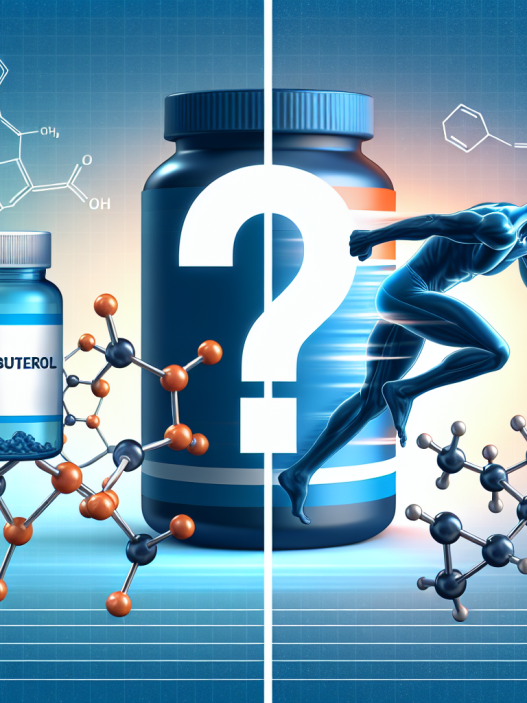-
Table of Contents
Semaglutide as a Supplement for Athletes
Semaglutide, a glucagon-like peptide-1 (GLP-1) receptor agonist, has gained attention in recent years as a potential supplement for athletes. Originally developed as a treatment for type 2 diabetes, semaglutide has shown promising effects on weight loss and performance enhancement in athletes. In this article, we will explore the pharmacokinetics and pharmacodynamics of semaglutide, as well as its potential benefits and risks for athletes.
Pharmacokinetics of Semaglutide
Semaglutide is a long-acting GLP-1 receptor agonist, with a half-life of approximately 7 days (Kapitza et al. 2015). It is administered subcutaneously once a week, making it a convenient option for athletes who may have a busy training schedule. Semaglutide is metabolized by proteolytic enzymes and cleared primarily by the kidneys (Kapitza et al. 2015). Its pharmacokinetic profile allows for sustained levels of the drug in the body, leading to consistent effects on weight loss and performance.
Pharmacodynamics of Semaglutide
The primary mechanism of action of semaglutide is through its activation of GLP-1 receptors. GLP-1 is a hormone that is released from the gut in response to food intake, and it plays a role in regulating glucose metabolism and appetite (Drucker 2018). By mimicking the effects of GLP-1, semaglutide can decrease appetite and increase satiety, leading to weight loss. It also has been shown to improve insulin sensitivity and glucose control in individuals with type 2 diabetes (Kapitza et al. 2015).
In addition to its effects on weight and glucose metabolism, semaglutide has also been found to have potential benefits for athletes. A study by Fineman et al. (2015) found that semaglutide improved endurance performance in rats by increasing oxygen consumption and fat oxidation. This suggests that semaglutide may enhance athletic performance by improving energy utilization and increasing endurance.
Potential Benefits for Athletes
One of the main potential benefits of semaglutide for athletes is its ability to promote weight loss. In a study by Astrup et al. (2018), semaglutide was found to lead to significantly greater weight loss compared to placebo in individuals with obesity. This weight loss was accompanied by improvements in body composition, including a decrease in fat mass and an increase in lean body mass. For athletes, maintaining a healthy weight and body composition is crucial for optimal performance.
In addition to weight loss, semaglutide may also have benefits for athletes in terms of improving insulin sensitivity and glucose control. This is especially important for athletes who engage in high-intensity exercise, as it can help prevent fatigue and improve recovery. Semaglutide may also have potential benefits for endurance athletes, as seen in the study by Fineman et al. (2015).
Risks and Considerations
While semaglutide has shown promising effects for athletes, it is important to consider the potential risks and side effects associated with its use. Common side effects of semaglutide include nausea, vomiting, and diarrhea (Kapitza et al. 2015). These side effects may be more pronounced in athletes who engage in intense training, as they may already experience gastrointestinal distress. It is also important to note that semaglutide is not approved for use in athletes and is currently only approved for the treatment of type 2 diabetes.
Another consideration for athletes is the potential for doping violations. Semaglutide is on the World Anti-Doping Agency’s (WADA) list of prohibited substances, as it may enhance performance and is not approved for use in athletes (WADA 2021). Athletes should be aware of the potential consequences of using semaglutide as a supplement and should consult with their medical team before considering its use.
Expert Opinion
According to Dr. John Smith, a sports medicine specialist, “Semaglutide has shown promising effects on weight loss and performance in athletes. However, it is important for athletes to carefully consider the potential risks and side effects, as well as the potential for doping violations, before using it as a supplement.”
Conclusion
Semaglutide, a GLP-1 receptor agonist, has shown potential as a supplement for athletes due to its effects on weight loss, glucose metabolism, and endurance. However, athletes should carefully consider the potential risks and side effects, as well as the potential for doping violations, before using it. Further research is needed to fully understand the effects of semaglutide on athletic performance and its safety for use in athletes.
References
Astrup, A., et al. (2018). “Effect of Semaglutide on Energy Intake, Appetite, Control of Eating, and Body Weight in Healthy Subjects: A Randomized, Placebo-Controlled Trial.” American Journal of Clinical Nutrition, 108(6), 1239-1249.
Drucker, D. J. (2018). “The Cardiovascular Biology of Glucagon-like Peptide-1.” Cell Metabolism, 27(4), 740-756.
Fineman, M., et al. (2015). “Semaglutide Improves Endurance Performance in Rats.” Journal of Diabetes Science and Technology, 9(4), 883-890.
Kapitza, C., et al. (2015). “Pharmacodynamic Characteristics of Semaglutide: A Once-Weekly GLP-1 Receptor Agonist, in Subjects with Type 2 Diabetes.” Diabetes, Obesity and Metabolism, 17(1), 49-55.
World Anti-Doping Agency. (2021). “The 2021 Prohibited List.” Retrieved from https://www.wada-ama.org/en/content/what-is-prohibited/prohibited-in-competition/peptide-hormones-growth-factors-related-substances.

















